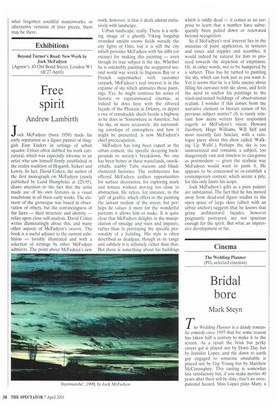Free spirit
Andrew Lambirth
Jock McFadyen (born 1950) made his early reputation as a figure painter of thuggish East Enders in settings of urban squalor. Critics often dubbed his work caricatural, which was especially irksome to an artist who saw himself firmly established in the realist tradition of Hogarth, Sickert and Lowry. In fact, David Cohen, the author of the first monograph on McFadyen (newly published by Lund Humphries at L29.95), draws attention to the fact that the artist made use of his own features as a visual touchstone in all these early works. The element of the grotesque was based in observation of others, but the convincingness of the faces — their structure and identity — relies upon close self-analysis. David Cohen writes illuminatingly about this, and many other aspects of McFadyen's oeuvre. The book is a useful adjunct to the current exhibition — lavishly illustrated and with a selection of writings by other McFadyen admirers. The point about McFadyen's new
work, however, is that it deals almost exclusively with landscape.
Urban landscape, really. There is a striking image of a ghostly Viking longship stranded amidst snowy fields outside the city lights of Oslo, but it is still the city which provides McFadyen with his alibi (or excuse) for making this painting — even though its true subject is the sky. Whether he is ostensibly painting the scuppered second world war wreck in Inganess Bay or a French supermarket with customer carpark, McFadyen's real interest is in the expanse of sky which animates these paintings. Yes, he might continue his series of historic or superannuated cinemas, as indeed he does here with the silvered façade of the Phoenix in Orkney, or depict a run of ramshackle sheds beside a highway as he does in 'Somewhere in America', but the sky, or more accurately, the surrounding envelope of atmosphere and how it might be presented, is now McFadyen's chief preoccupation.
McFadyen has long been expert at the urban context, the specific decaying backgrounds to society's breakdown. No one has been better at these wastelands, snookerhalls, scabby Tube stations and blindshuttered factories. The architecture has offered McFadyen endless opportunities for surface decoration, for exploring mark and texture without moving too close to abstraction. He refers, for instance, to the 'gift' of graffiti, which offers to the painting the instant realism of the street; but perhaps he values it most for the wonderful patterns it allows him to make. It is quite clear that McFadyen delights in the manipulation of smudge and stain and impasto, rather than in portraying the specific personality of a building. His style is often described as deadpan, though in its range and subtlety it is infinitely richer than that. But there is something about his buildings which is oddly dead — it comes as no surprise to learn that a number have subsequently been pulled down or renovated beyond recognition.
So if McFadyen's real interest lies in the minutiae of paint application, in textures and tones and stipples and scumbles, it would indeed be natural for him to proceed towards the depiction of emptiness. Or, in other words, not to be hampered by a subject. Thus has he turned to painting the sky, which can look just as you want it. Yet it seems that he is a little uneasy about filling his canvases with sky alone, and feels the need to anchor his paintings to the tried-and-tested buildings of observational realism. I wonder if this comes from the narrative element or literary nature of his previous subject matter? (It is surely relevant how many writers have responded eagerly to McFadyen's vision: Howard Jacobson, Hugo Williams, Will Self and most recently lain Sinclair, with a catalogue piece about this show called 'Walking Up Walls'.) Perhaps the sky is too unstructured and romantic a subject, too dangerously vast and timeless to categorise as postmodern — given the realistic way McFadyen would want to paint it. He appears to be concerned to re-establish a contemporary context, which seems a pity, for this only limits his scope.
Jock McFadyen's gifts as a pure painter are substantial. The fact that he has moved away from dead-end figure studies to the open space of large skies (albeit with an urban anchor) suggests that he knows that grimy architectural façades, however poignantly portrayed, are not spacious enough for the spirit. But what an impressive development so far.


























































 Previous page
Previous page